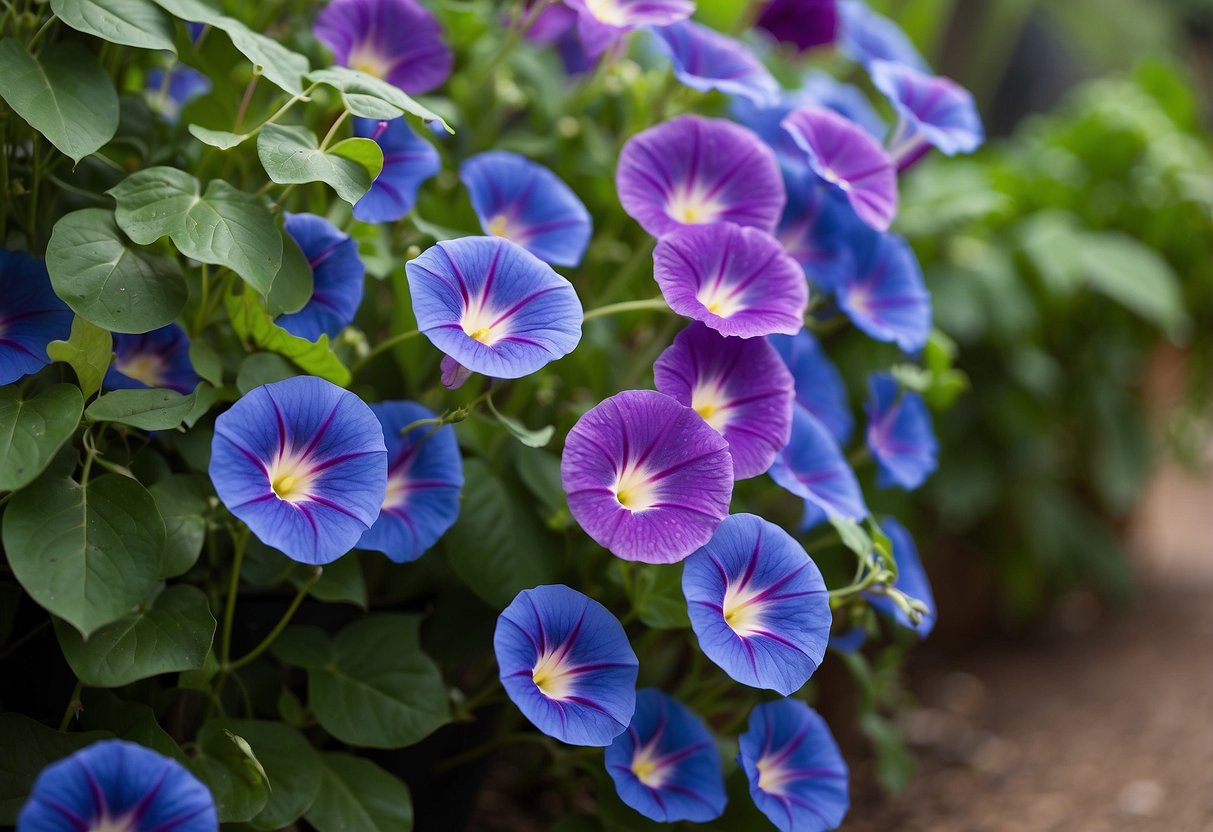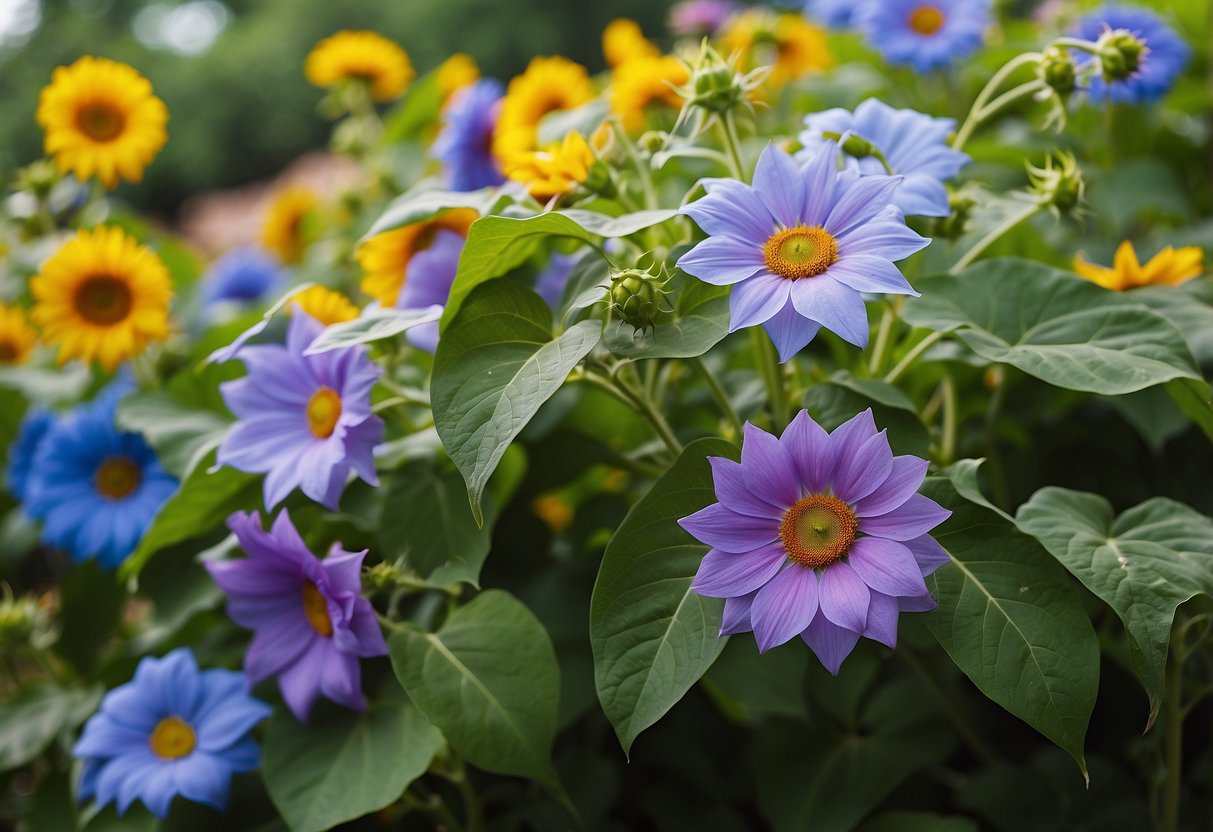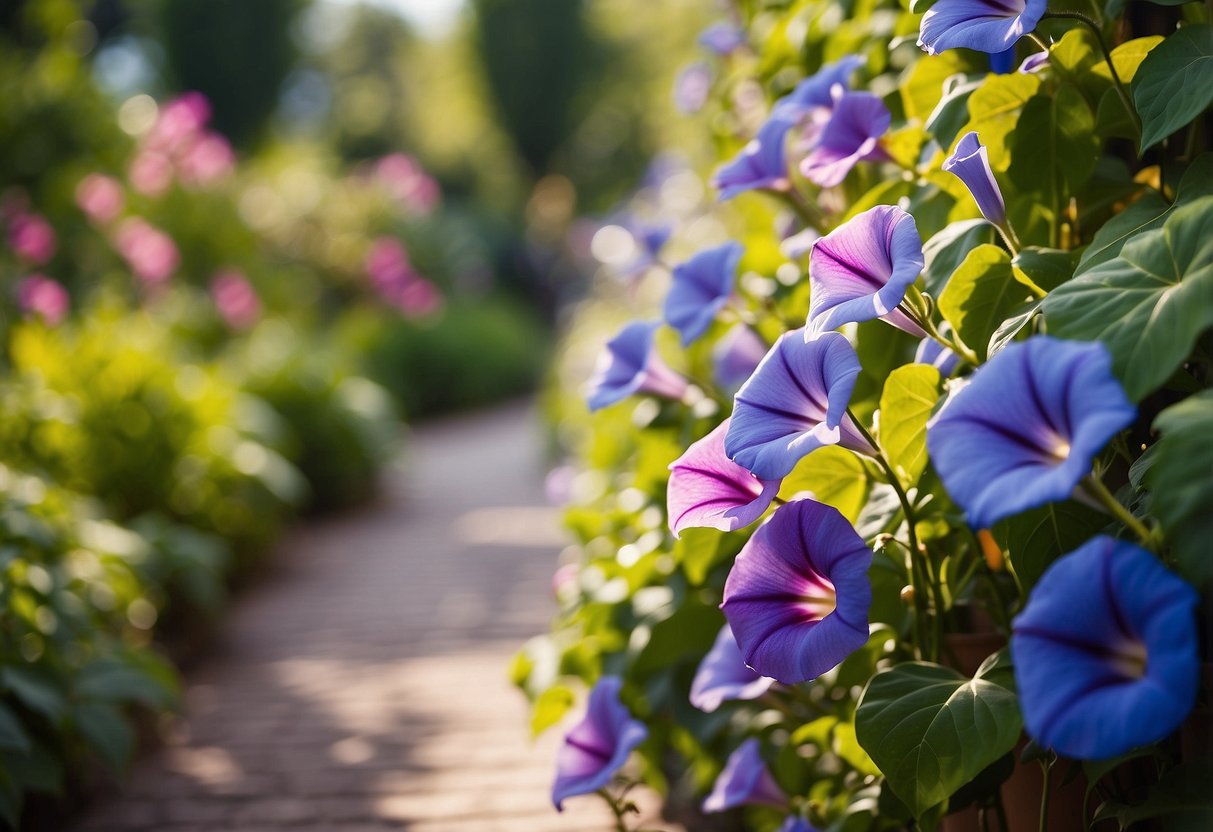Morning Glory Flower Garden Ideas: Brighten Up Your Yard
If you want to brighten up your garden with beautiful blooms, morning glories are a fantastic choice. These vibrant flowers can add a splash of color to any space with their trumpet-shaped blossoms and can climb trellises, fences, or even a simple string.

Morning glory flowers can transform your garden with their vivid colors and climbing nature. Whether you’re a seasoned gardener or just starting out, there’s a morning glory garden idea that will suit your style. Dive in to explore the possibilities and get inspired to create your own stunning morning glory haven.
1) Planting Blue Morning Glories

Blue morning glories are beautiful and easy to plant. First, you should soak the seeds for 24 hours before planting to help them sprout.
You will need to make small holes about 1/4 inch deep in the soil. Space these holes about six inches apart.
Make sure the soil stays moist until you see sprouts. Adding compost can help improve soil quality and give your flowers a good start.
For more details, you can check out this guide.
2) Incorporating Trellises and Arches

Using trellises and arches can make your morning glory garden look stunning. You can opt for a metal trellis, which is sturdy and perfect for these flowers. Paint it black to make the foliage stand out.
Another idea is to use a wood entryway frame. Placing a wooden plank or a jamb on a wall creates a natural support structure.
You could also go for a classic garden arch. This gives your morning glories plenty of vertical space to climb and adds a charming touch to your garden.
3) Mixing Morning Glories with Sunflowers

Mixing morning glories with sunflowers can create a stunning display in your garden.
The tall, bright sunflowers provide a sturdy backdrop for the climbing morning glories.
As the morning glories climb, their vibrant flowers contrast beautifully against the big sunflower heads.
This combination not only looks great but also adds height and depth to your garden.
For more inspiration, check out the Morning Glories and Sunflower combinations and see how others have made it work.
4) Designing a Morning Glory Fence

Transforming your garden with a morning glory fence can add vibrant color and charm. Start by picking a sturdy structure, like a wooden fence or metal trellis.
Ensure the fence gets plenty of sunlight. Morning glories love the sun and thrive in bright locations. Use high-quality soil for planting at the base of the fence.
Choose a variety like ‘Heavenly Blue’ for striking blue flowers. Water regularly and provide support as they climb. For creative ideas, check out these morning glory fence ideas.
5) Using Eco-Friendly Garden Pots

Choosing eco-friendly garden pots for your morning glory flowers is a great way to help the environment. Look for biodegradable pots made from materials like coconut coir, peat, or recycled paper.
You can also repurpose containers you already have. Consider using old buckets, wooden boxes, or even tin cans. Just make sure they have drainage holes.
Another option is to buy pots made from recycled plastics or natural materials like bamboo. These options can give your garden a lovely, earthy look while being kinder to the planet.
6) Morning Glories for Window Boxes

Morning glories can add charm to your window boxes. They are climbers, so they need some support. Place a small trellis or some thin wires in your window box.
To start, plant the seeds about 1/4 inch deep. Make sure to soak the seeds overnight to help them germinate. They love sunny spots, so pick a window that gets plenty of sunlight.
Water the plants regularly but don’t let the soil get too soggy. You can enjoy their beautiful blooms every morning, making your windows look even more attractive. With the right care, your morning glories will thrive.
7) Vertical Gardening with Morning Glories

Morning glories are perfect for vertical gardening. These climbing vines can reach heights over 10 feet. You just need a strong support.
A metal trellis offers sturdy support. Paint it black for a nice contrast with the green leaves. A wooden frame also works well and adds a natural look.
If you have a fence, morning glories can easily grow along it. This transforms a plain wooden fence into a beautiful flower wall.
8) Selecting Colorful Morning Glory Varieties

When picking colorful morning glories, you’ll find a vast array of choices.
The Heavenly Blue cultivar offers classic sky blue flowers with white throats.
For something different, the Cardinal Climber has red, star-shaped blooms that stand out.
Consider the Caprice, with its sky blue flowers and lavender centers. Its vibrant colors can brighten any garden space.
9) Companion Planting with Morning Glories

Morning glories thrive next to plants that enjoy similar conditions. They do best in full sun and well-drained soil.
Consider pairing them with sunflowers. These tall plants provide natural support for morning glory vines.
Marigolds make another great companion. They help deter pests from both plants.
Nasturtiums can enhance the beauty of your garden alongside morning glories.
Morning glories also look stunning with zinnias.
Mixing these plants can create a colorful and functional garden space. Make sure to give each plant enough room to grow and bloom.
10) Creating a Morning Glory Pathway

Imagine walking through a beautiful garden path with morning glories climbing on either side. To create this, you need to plan well.
First, mark out the pathway you want to decorate. Install trellises or arches along the path.
Plant morning glory seeds or seedlings at the base of the trellises. Water them regularly and watch them grow.
Soon, your pathway will be covered in vibrant morning glories, making your garden a magical place to explore.
Choosing the Right Varieties

When selecting morning glories for your garden, think about whether you want annuals or perennials. Also, some varieties have unique colors and features that can enhance your garden’s look.
Annual vs. Perennial Morning Glories
Annual morning glories (Ipomoea spp.) are popular because they grow quickly and produce vibrant flowers in a single season. These types can easily reach 15-20 feet tall, perfect for covering fences or arbors.
Perennial morning glories (such as Ipomoea indica) are more suited for mild climates. They come back year after year and can offer lush greenery and flowers for an extended period. One thing to note is that perennials may spread aggressively, so it’s good to keep them in check.
If you live in colder climates, annuals might be more practical since they’re less likely to suffer from frost damage. In warmer regions, perennials could add a consistent, long-lasting charm to your garden.
Popular Varieties and Their Characteristics
Heavenly Blue: Famous for its sky-blue flowers with white throats. This type is an annual that can brighten up any garden with its cheerful color.
Moonflower (Ipomoea alba): These tropical white morning glories open in the evening and release a sweet scent, making them unique and ideal for night gardens. Moonflower is an annual.
Scarlett O’Hara: Known for its deep magenta flowers. This variety has become rare, but finding and growing true seeds can be rewarding. It is generally an annual.
Caprice: With its sky blue and lavender star-like center, Caprice offers striking colors. It is a vigorous grower, reaching up to 20 feet long, and is an annual.
Chocolate Rose Silk: This rare variety features mauve flowers with white picotee edges. Not as showy but still beautiful, this twining annual is perfect for adding subtle elegance to your garden.
By carefully choosing the right types, you can tailor your garden to be as beautiful and unique as you desire.
Planting and Soil Preparation

Planting morning glories properly ensures healthy growth. Using the right soil and planting methods is key to a vibrant flower garden.
Ideal Soil Conditions
Morning glories thrive in well-draining soil. Prepare the soil by mixing 1 part perlite with 3 parts soil, or 1 part sand with 2 parts soil. Avoid combining sand with clay-heavy soil, as this can hinder drainage.
It’s best to avoid overly rich soil, which can lead to more leaves and fewer flowers. Instead, morning glories prefer soil that is somewhat lean. A pH between 6.0 and 7.0 is ideal for these flowers.
To improve your soil, consider adding compost or aged manure. These additions boost soil structure while providing necessary nutrients without over-fertilizing.
Best Planting Times and Techniques
The optimal time to plant morning glories is after the last frost. Wait until the soil has warmed up to ensure the seeds germinate.
Steps for Planting:
- Soak seeds for 24 hours before planting to soften the outer coat.
- File down seeds gently to improve germination.
- Plant seeds 1/4 inch deep and space them 6 to 12 inches apart for ideal growth.
Water the seeds well and keep the soil moist until they sprout. Morning glories can also be planted near a trellis or fence to support their climbing habit.
Caring for Your Morning Glory Garden

Morning glories are beautiful and easy to grow, but they do require some care to thrive. From proper watering to fertilization and pruning, each step is essential for maintaining a healthy morning glory garden.
Watering Needs
Morning glories need consistent moisture, especially during hot weather. Water them deeply once a week or more if the soil dries out quickly.
Check the soil regularly to ensure it’s not too dry. Use a mulch layer to help retain moisture.
Water the plants in the morning to avoid fungal diseases. Make sure you water the base of the plant rather than the foliage to prevent mildew.
Fertilization Tips
Morning glories aren’t heavy feeders, but they do benefit from light fertilization. Use a balanced fertilizer every four to six weeks during the growing season.
Avoid high-nitrogen fertilizers as they can lead to lush foliage but fewer flowers. Compost can also be added to improve soil fertility.
Mix the fertilizer into the soil gently around the plant’s base without disturbing the roots. Always water after fertilizing to help the nutrients reach the roots.
Pruning and Training the Vines
Pruning helps control the growth and encourages more blooms. Trim back any overgrown or unhealthy vines regularly.
Training the vines to grow on a trellis or support will improve air circulation and aesthetics. Use soft ties or clips to guide the vines gently.
Pinch back the tips of the vines to promote bushier growth and prevent them from becoming too leggy. Regular pruning keeps your morning glories looking neat and healthy.
Dealing with Pests and Diseases

Morning glories are beautiful, but they can face challenges from pests and diseases. You’ll need to recognize common problems and learn how to manage them.
Common Pests and How to Handle Them
Morning glories often attract small pests like aphids and spider mites. Aphids can be removed by using a hard stream of water, known as syringing. You should do this twice a week to keep them under control.
If you notice speckled or bronzed leaves, spider mites might be the problem. Again, syringing can help, but if the infestation is severe, you may need a miticide.
Larger animals like rabbits, deer, and snails can also damage your plants. Fencing your garden or using repellents may help keep these animals away.
Preventing and Treating Diseases
One common disease in morning glories is canker, which causes the stem to sink and turn brown. This fungus spreads quickly, so you should cut away and dispose of the infected parts immediately to save the plant.
Root rot is another issue, often caused by soggy or poorly drained soil. Wilting and yellowing leaves are signs of this condition. Ensure your soil drains well and avoid overwatering to prevent root rot.
Proper garden hygiene helps stop diseases from spreading. Remove dead leaves and debris and avoid overcrowding plants so they get enough air circulation. This reduces the risk of fungal infections and keeps your morning glories healthy.
For more information on pests, visit Identifying Common Pests. To learn more about diseases, check out Common Morning Glory Plant Diseases.







